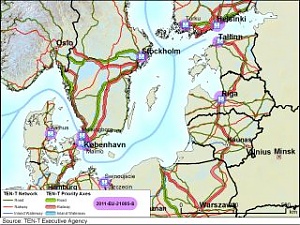Energy, Estonia, EU – Baltic States, Forum, Gas, Port, Transport
International Internet Magazine. Baltic States news & analytics
Saturday, 20.04.2024, 08:35
Baltic ports go for LNG
 Print version
Print version |
|---|
The project was initiated by the Baltic Ports Organization (BPO). The project is co-financed by EU TEN-T Multi-Annual Program, writes LETA.
The aim of the project LNG in the Baltic Sea Ports is to develop a harmonized approach towards LNG bunker filling infrastructure in the Baltic Sea region. Each of the project partners is planning the development of the port infrastructure to offer LNG bunker for ship-owners in the future. The works in the ports focus on pre-investment studies such as EIA, feasibility studies for LNG terminals or bunkering vessels, project designs, regional market studies, safety manuals.
The project was initiated by BPO as the reaction to the new rules in Sulphur Emission Control Area (SECA) covering the Baltic Sea, North Sea and English Channel. Several fuel alternatives have been put forward of which one of the choice is the use of LNG. To promote LNG as a competitive alternative to Heavy Fuel Oil (HFO), Marine Diesel Oil/Marine Gas Oil (MDO/MGO) several initiatives are presently planned or initiated in the Baltic Sea region. The project LNG in the Baltic Sea region is one of them.
The results of the pre-investment studies in eight ports will allow starting the physical investments in infrastructure for LNG bunkering. Moreover, project works include so called “stakeholder platform”, which will facilitate the discussion among various actors involved in infrastructure development for LNG bunkering, such as ship-owners, gas infrastructure companies, energy traders, bunkering companies.
To secure the transition from traditionally fuelled engines, ship-owners and their operators needs to be sure that there are possibilities to shift vessels between ports in the area without losing the access of LNG bunkers. A harmonised development of LNG bunker filling infrastructure will reduce installation costs and also build up knowledge and “know-how” to serve as reference for others ports both when it comes to standards, but also for equipment, costs, manning etc. Therefore; one of the project output will be the LNG Guidebook containing the best practices and recommendations on how to develop the LNG infrastructure in the ports.
The total estimated eligible cost for the common actions is 4 785 040 euro. Half of this amount is contributed by EU TEN-T Program. The completion date of the project is 31 December 2014.








 «The Baltic Course» Is Sold and Stays in Business!
«The Baltic Course» Is Sold and Stays in Business!

